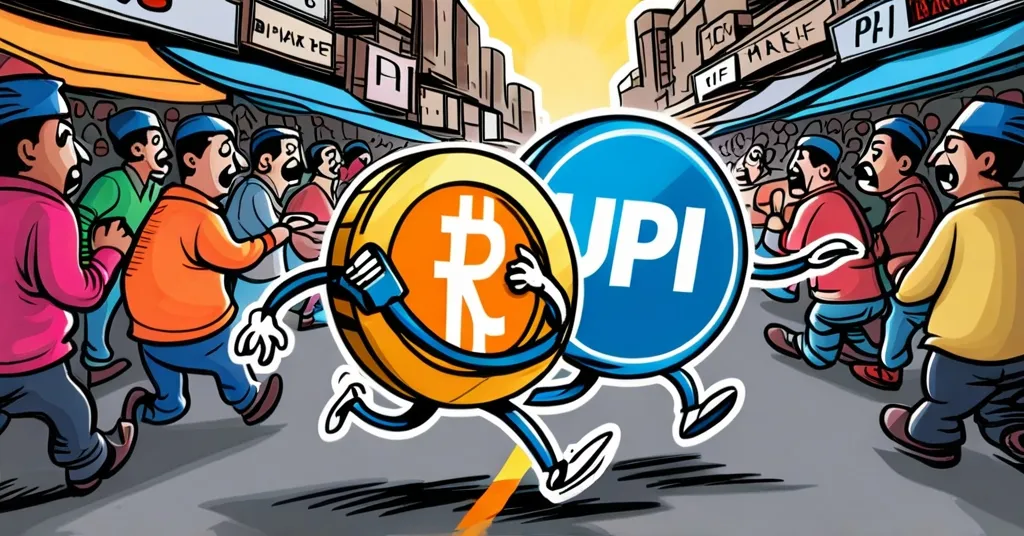RBI’s Digital Rupee Struggles Against UPI Dominance in India

Is RBI’s Push for Instant Payments Hindering CBDC Adoption?
In Mumbai, trying to pay for your chai with the new digital rupee might feel like bringing a knife to a gunfight, as everyone around you swipes their UPI. The Reserve Bank of India (RBI) rolled out its blockchain-based Central Bank Digital Currency (CBDC), the digital rupee, over two years ago with high hopes. Yet, in a market dominated by UPI, adoption remains elusive, like trying to find a quiet corner in a bustling Indian market.
- India’s CBDC pilot struggles to gain traction
- UPI’s dominance overshadows digital rupee efforts
- RBI explores new functionalities to boost CBDC adoption
Launched in late 2022, India’s digital rupee pilot has yet to capture the imagination of the masses. An International Monetary Fund (IMF) report notes, “In India, the digital rupee pilot has yet to achieve mainstream adoption among India’s vast population, especially in the presence of the widely adopted Unified Payments Interface (UPI).” By May 2024, the e-rupee in circulation was just 3.23 billion rupees, a mere drop in the ocean compared to the 35.4 trillion rupees in banknotes.
UPI, on the other hand, has become the juggernaut of India’s digital payment landscape. From 2019-2020 to 2023-2024, UPI transactions surged from 12.5 billion to a staggering 131 billion, accounting for 80% of all digital payment volumes. Its ease, speed, and zero-cost nature have set a high bar, making it tough for the digital rupee to compete. As Rohan Sharan, founder and CEO of Timechain Labs, puts it, “The ease, speed, and zero-cost nature of UPI transactions mean the e-rupee must offer unique advantages such as offline payments, programmable features, or enhanced security to attract users.”
The RBI isn’t throwing in the towel, though. They’re ramping up efforts to make the digital rupee more appealing by integrating it with commercial papers and certificates of deposits—think of these as short-term IOUs issued by companies—and enhancing functionalities like offline payments and programmability. Former RBI Governor Shaktikanta Das expressed cautious optimism: “While the number of [CBDC] transactions have reached a high of 1 million a day, we still see preference for UPI among the retail users. We, of course, hope that this will change going forward.”
The RBI’s ambitions extend beyond India’s borders. They’re in talks with the Hong Kong Monetary Authority (HKMA), the US Federal Reserve, and SWIFT to explore cross-border CBDC payments. This could give the digital rupee a chance to shine where UPI’s reach is limited, much like a local hero trying to make it big on the world stage.
But India isn’t alone in this struggle. Globally, CBDCs are facing similar adoption hurdles. The Bahamas, Jamaica, Nigeria, and China are all grappling with getting their digital currencies off the ground. Sharat Chandra, founder of EmpowerEdge Ventures, observes, “As users become accustomed to seamless transactions through UPI, they may be less inclined to adopt a new digital currency unless it offers distinct advantages.”
To stand a chance, the RBI knows it needs more than just technological tweaks. Aggressive awareness campaigns, broader distribution methods, and stronger incentives are crucial. Raj Kapoor, founder of India Blockchain Alliance, points out the overlap: “UPI and CBDCs have some overlapping functions, which means CBDCs need to offer something extra to stand out.”
So, where do we go from here? The digital rupee has the potential to be a game-changer in the financial revolution, but it’s currently playing second fiddle to UPI’s symphony of instant payments. For those of us who champion decentralization and the disruption of the status quo, the slow adoption of CBDCs is both a challenge and an opportunity. It’s a stark reminder that even the most promising technologies need the right incentives and user education to take off.
As we keep an eye on this space, it’s clear that the road ahead for CBDCs is fraught with challenges, yet brimming with possibilities. The RBI’s efforts to innovate and expand the digital rupee’s reach are crucial steps in this evolving landscape. Whether it can overcome UPI’s dominance and carve out its own niche remains to be seen. But in the world of crypto, the only constant is change.
Key Takeaways and Questions
- What is the current state of CBDC adoption in India?
The adoption of the digital rupee remains low, with a circulation of 3.23 billion rupees as of May 2024, compared to 35.4 trillion rupees in banknotes.
- How does UPI affect the adoption of CBDCs in India?
UPI’s ease, speed, and zero-cost transactions have overshadowed the digital rupee, making it challenging for CBDCs to gain traction among users accustomed to UPI.
- What strategies is the RBI employing to boost CBDC adoption?
The RBI is exploring the use of CBDCs in commercial papers and certificates of deposits, enhancing programmability and offline capabilities, and discussing cross-border payment possibilities with international partners.
- What are the global challenges faced by CBDCs?
Globally, CBDCs face issues such as low merchant participation, limited integration with banking systems, poor user education, and competition from established private payment systems.
- What could be the future outlook for CBDC adoption in India?
The future adoption of CBDCs in India might require aggressive awareness campaigns, wider distribution methods, and stronger incentives to compete with UPI’s established position in the market.



